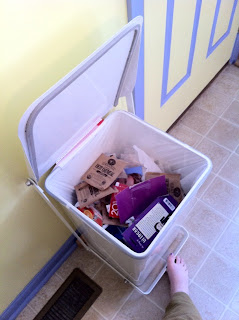Matt and I recently watched Objectified, a documentary that, as the title suggests, is supposed to be about our relationship to the things we own. It depicts instead the relationship of designers to the things they've designed. I'm not sure what the title should have been. Maybe "Designers on Designing: Worried about Your Comfort and the Environment -- Sort of." The focus of the film is design process and philosophy. A light sustainability theme runs through and writer Rob Walker, whose work really does look at that relationship to the things we own, provides a counterpoint.
At least two of the designers discussed how designed objects can and should get better with time. A briefcase, one pointed out, becomes more beloved once the shine literally wears off.
 |
| My briefcase and a small Poe |
My friend Carl once lent a pristine leather briefcase to his mother until it was appropriately battered. I enjoy breaking in my own stuff and creating a history, but I sympathize with Carl because I remember being incredibly embarrased in middle school -- well, all the time --- but in particular, by new and sparkling white tennis shoes. If only they could have come pre-battered, like jeans in the 90s. (Later, as college student, I wore loafers so beaten that I adapted a shuffling walk to keep them on my feet and jeans so legitimately threadbare that the orange tights I wore with them were a style choice. I loved 90s grunge -- it meant I didn't have to throw out beloved clothes, part with my beloved stuff.)
The documentary showed a design team trying to come up with a better toothbrush and that lead me to my new toothbrush, the handle of which is made of recycled U.S. currency. Time for a new brush? I keep the ergonomic handle and replace the head. My teeth are not only clean, but also righteous.
We, being the righteous recyclers, reusers and composters that we are, don't throw much out beyond the occasional disposable toothbrush head, but trash happens -- even to righteous people such as ourselves. It is here that I will put in a plug for the the best trash can ever.
Or, close to here. First, I will vent.
Trash cans have come a long way since I was a kid. We want our homes to be comfortable and now that the kitchen is the center of our universe, a dirty plastic bin with a swinging lid has no place in our pleasant environs. Trash cans are now part of the decor: hipster trashcans, retro trash cans, traditional trash cans, which for some reason, are wicker. Perhaps wicker evokes our colonial roots? If I ever meet someone with a wicker trash can, I'll ask.
My friends are modern and cool, but not self-concious or hipster about it, so almost everyone I know has a variation on the stainless steel column with a foot pedal. These are things of beauty.
Ephemeral beauty. Which is odd. For a garbage bin.
Simplehuman is probably the brand of choice for these things. My first was a knock-off. My parents bought it for me at the Knock-off Store because they are practical people. Knock-off Can was solidly built and worked well for about six months. Then, the plastic pedal broke and left a sharp metal stick in its place. Being my parent's daughter, I fixed the problem with duct tape, which did very little for my pleasant environs, but increased my DIY cred half a notch.
A fully notched DIYer would fashion another pedal with no more than tweezers and a discarded tie rack. I have a collection of tweezers, but lacked the skills and vision. And, I'd just Freecycled my last tie rack.
Enough playing around, I thought. To Target. My next trashcan was a brand-name objet'd art with a rounded triangle footprint that hearkened to both the past and the future. Art deco? Perhaps postmodern. No footpedal interrupted its smooth design. I lightly tapped the lid; it gently floated to up like a butterfly lighting on my shoulder, giving me a moment to contemplate the trash held in my hands and my place in the world. With this beauty in my kitchen corner, I was just as likely to think of old-style chrome glam as the meditave quiet of a birch grove.
Sure, I didn't actually want to comtemplate my trash, and the chrome-colored cannister showed more fingerprints than a dusted crime scene, but I could ignore that. I just wouldn't touch the sides and being forced to contemplate my waste gave me more reason to recycle. I could not, however, ignore the tiny plastic engineering marvel that created the pneumatic effect ... because it broke within six months. The entire lid was useless. To keep the can meant I would see (and smell) my trash. I do eat meat occasionally, so Knock-off Can came back for a while. I refreshed the duct tape.
But, it didn't last. The duct tape was failing; my right foot was developing a callous. Knock-off can was relegated to the project room where it would serve a dual function of garbage receptacle and future project.
 |
| Contemplating trash: it's now a choice |
The best trash can ever has no tiny plastic parts. It has a simple straightforward design that instills faith. And, love.
And, so I have now I've been introduced to online school supplier catalogs. Lecterns and activity tables. Adjustable media carts and tiny chairs. Stuff built to take the abuse of a thousand furniture-eating demon-children and the mistreatment of underappreciated civil servants. Stuff built to last forever. *Sigh*
















